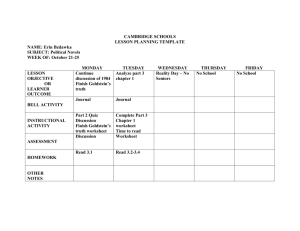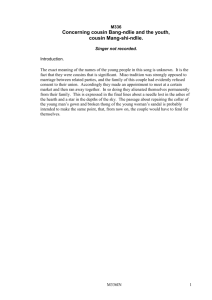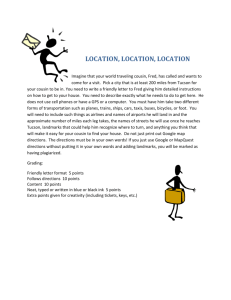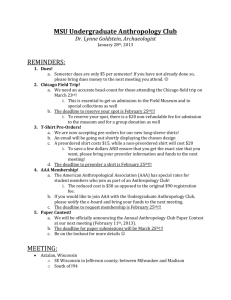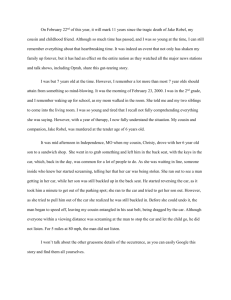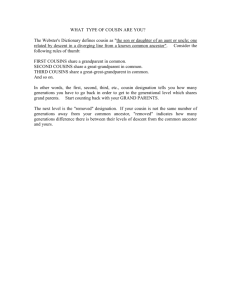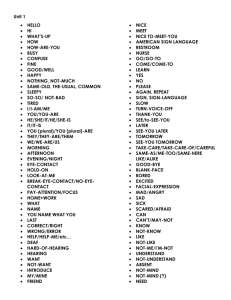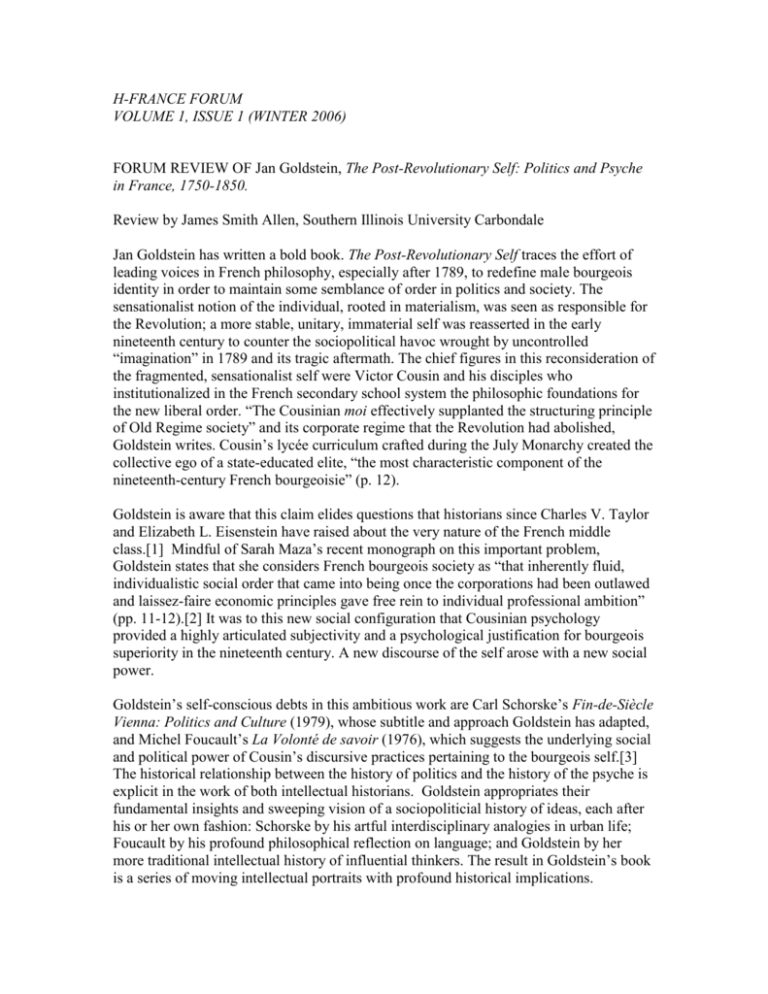
H-FRANCE FORUM
VOLUME 1, ISSUE 1 (WINTER 2006)
FORUM REVIEW OF Jan Goldstein, The Post-Revolutionary Self: Politics and Psyche
in France, 1750-1850.
Review by James Smith Allen, Southern Illinois University Carbondale
Jan Goldstein has written a bold book. The Post-Revolutionary Self traces the effort of
leading voices in French philosophy, especially after 1789, to redefine male bourgeois
identity in order to maintain some semblance of order in politics and society. The
sensationalist notion of the individual, rooted in materialism, was seen as responsible for
the Revolution; a more stable, unitary, immaterial self was reasserted in the early
nineteenth century to counter the sociopolitical havoc wrought by uncontrolled
“imagination” in 1789 and its tragic aftermath. The chief figures in this reconsideration of
the fragmented, sensationalist self were Victor Cousin and his disciples who
institutionalized in the French secondary school system the philosophic foundations for
the new liberal order. “The Cousinian moi effectively supplanted the structuring principle
of Old Regime society” and its corporate regime that the Revolution had abolished,
Goldstein writes. Cousin’s lycée curriculum crafted during the July Monarchy created the
collective ego of a state-educated elite, “the most characteristic component of the
nineteenth-century French bourgeoisie” (p. 12).
Goldstein is aware that this claim elides questions that historians since Charles V. Taylor
and Elizabeth L. Eisenstein have raised about the very nature of the French middle
class.[1] Mindful of Sarah Maza’s recent monograph on this important problem,
Goldstein states that she considers French bourgeois society as “that inherently fluid,
individualistic social order that came into being once the corporations had been outlawed
and laissez-faire economic principles gave free rein to individual professional ambition”
(pp. 11-12).[2] It was to this new social configuration that Cousinian psychology
provided a highly articulated subjectivity and a psychological justification for bourgeois
superiority in the nineteenth century. A new discourse of the self arose with a new social
power.
Goldstein’s self-conscious debts in this ambitious work are Carl Schorske’s Fin-de-Siècle
Vienna: Politics and Culture (1979), whose subtitle and approach Goldstein has adapted,
and Michel Foucault’s La Volonté de savoir (1976), which suggests the underlying social
and political power of Cousin’s discursive practices pertaining to the bourgeois self.[3]
The historical relationship between the history of politics and the history of the psyche is
explicit in the work of both intellectual historians. Goldstein appropriates their
fundamental insights and sweeping vision of a sociopoliticial history of ideas, each after
his or her own fashion: Schorske by his artful interdisciplinary analogies in urban life;
Foucault by his profound philosophical reflection on language; and Goldstein by her
more traditional intellectual history of influential thinkers. The result in Goldstein’s book
is a series of moving intellectual portraits with profound historical implications.
I would like to consider Goldstein’s achievement from four different perspectives or
contexts, namely, from those defined by historical continuities, audiences, intellectual
conventions, and gender. In light of the long history of French self-fashioning, its
mediation by various reading publics, its most prominent literary manifestations, and its
variation in the personal writings by women in the period, I see the bourgeois self as less
imposing a phenomenon than Goldstein does. It is certainly not the only historical self in
modern France. Other sources of individual identity, including those outside of the
French national setting, make the bourgeois male ego something less than it seems, at
least for those who never read the philosophy and textbooks of Victor Cousin and his
loyal circle.
I. An argument can well be made that the French bourgeois self was long in the making,
perhaps since the Middle Ages.[4] Guilbert de Nogent’s discovery of the self in the
twelfth century marks one point of departure. The early modern aristocracy certainly had
a well-developed sense of self, as Michel de Montaigne demonstrated in his reflective
essays and as Madame de Sévigné suggested in her letters to Madame de Grignon. The
first-person narrative was familiar well before René Descartes’s famous cogito ergo sum.
As Norbert Elias has argued for a self-conscious, civilizing process in France, the
creation of a courtly society in which the manners and mores of a much tamed nobility
provided the model for other social orders, including an increasingly evident, urban
middle class, who were anxious to ape their betters.[5] The duc de Saint-Simon’s
memoirs were as much about their author as they were about the Sun King and his notion
of “l’état, c’est moi.” Personal accounts of lesser mortals were not long in coming,
culminating in Rousseau’s Confessions (1782), arguably the first bourgeois antimemoir.[6]
The religious confessional mode, in the style of Saint Ignatius Loyola’s spiritual
exercises, explored the self, albeit a sinful one, irrespective of social class.[7] Aristocrat
and bourgeois alike indulged in comparable introspection, during the on-going conflict
over Jansenism from the seventeenth century onward. Blaise Pascal’s Pensées (1670) had
an enormous influence on the French Catholic faithful; his call to calm reflection was still
quoted by diarists in the nineteenth century.[8] Indeed, one might well argue that the very
idea of the modern bourgeois self was religious in its origins, so pervasive were the
earliest pious confessions and revelations. The soul-searching of the CounterReformation in both the Jansenist and the Jesuit traditions continued into the
Enlightenment, notwithstanding the growing resistance to this obscurantist legacy among
the lumières.
It was certainly no accident that Cousin drew on this literature for his own version of
bourgeois introspection. As Goldstein points out, Cousin was deeply interested in the
French “family of méditatifs intérieurs,” especially in Maine de Biran’s notebooks which
inspired his introspective method (pp. 129-38). Earlier iterations of the French self were,
of course, less stable, less assertive, less secular, and much less exclusively bourgeois,
but they remained profoundly central to Cousin’s work to fashion one for himself and his
students. The sensationalist fragmentation of the self did not eliminate entirely a long
tradition of self-definition among French meditative writers, however shallow and hollow
were the occasional introspections of important Enlightenment thinkers, such as Voltaire
and Condillac, who were more concerned with human reason, natural law, and cultural
progress.
II. Goldstein makes much of the long-term impact of the Cousianian moi in the
nineteenth and early twentieth centuries, marked by the institutionalization of Cousin’s
psychology in the philosophy curriculum of lycées nearly everywhere in France from the
July Monarchy onward (subject to a brief interruption during the Second Empire thanks
to the Falloux Law). But given the complexity of documenting so pervasive an
intellectual presence, I would question just how influential were his teachings outside the
French université. The curriculum and its advocates, especially Cousin’s loyal
instructors, surely taught the new bourgeois self, but that does not mean that the students
necessarily learned it for themselves. Without careful, systematic review of student
notebooks, examinations, and correspondence, it would be hard to say if such a notion
came from the schools or from the culture and society they attempted to counter. The
principal exemplar Goldstein studies, Ernest Renan, acquired his meditative habits not in
the lycées but in the Saint Sulpice seminary (pp. 233-37).
The audience for Cousin’s complex activity almost certainly had other things in mind.
Numerous are the accounts of student resistance to the constraints of the schools that
students attended in the nineteenth century, including open rebellion on occasions noted
in the Ministry of Public Instruction during the July Monarchy. Students read selectively
in their assigned texts and sought other works that were of more interest but far from the
established syllabus. The abbé de Lamennais’s Paroles d’un croyant (1834) circulated in
many more and much larger editions than any of Cousin’s works, including his most
important textbooks.[9] In light of publication data available in the Ministry of the
Interior, the very notion of the self in the first half of the nineteenth century may well
owe more to the Romantics than to the Cousinians. According to Martyn Lyons, the ego
depicted in Sir Walter Scott’s novels, the first national bestsellers, is likely to have
appealed substantially more to lycée students.[10]
My own work in the history of reading suggests a much more complicated “transfer of
knowledge” from author to reader.[11] The text is far from the only cultural filter
mediating intellectual exchange. Much owes to the competing circulation of printed
matter, from posters to encyclopedias, and the readers’ access to it on the street and in
lending libraries. Literate skills remained problematic even for bourgeois audiences, as
literati such as Gustave Flaubert and George Sand often lamented. Political ideologies
and cultural norms also affected the way readers responded to texts. It took almost a
century for the Neoclassical values of tradition, balance, and order to fade in the face of
more Romantic notions of emotion, imagination, and self-identification. From what one
can glean from student notebooks, book reviews, diaries, and fan mail, for example, the
responses to Madame de Staël were worlds apart from those for Marcel Proust a century
later, almost as distant as the authors and their writings themselves. Such patterns must
have interfered with the ready acceptance of the Cousinian moi.
III. Arguably the most notable literary ego of all in early nineteenth-century France was
François-René de Chateaubriand.[12] His Mémoires d’outre-tombe (1848-50) were a
huge success a half century after his equally influential Romantic work, Le Génie du
christianisme (1802), with its early chapters devoted to the narratives of Atala and René,
rivaled only by the author’s appreciative biography of Napoleon in the Mémoires. The
Romantics may not have been exemplary bourgeois, but their works appealed to many
readers who were. The oversized self constructed at length by Chateaubriand became a
model for others who were tempted to narrate their own personal lives in the period. The
young Victor Hugo was not alone in seeking to become Chateaubriand or nothing, and
still others would say the same thing about Hugo and his larger-than-life literary ego. In
response to the creative sterility of eighteenth-century Neoclassicists, the Romantics
celebrated the self, its imaginative leaps, its demonic excesses, its unruly creativity in
ways that run counter to the staid, controlled, unitary self Cousin sought to establish for
bourgeois elites.
Besides the Romantics, there were the countless self-writers in the nineteenth century. By
mid-century it had become a veritable bourgeois obsession. Memoir and autobiography
were more formal manifestations of the impulse, which was expressed more informally in
diaries and personal correspondence. Philippe Lejeune, the doyen of autobiographical
writings in France, has argued that this preoccupation in the nineteenth century also
developed self-discipline; parents carefully monitored the self-writing instinct as much as
they could to ensure that children and adolescents were not engaged in “unhealthy”
activities.[13] But the motivation was genuine and the surveillance imperfect. The
introspective habits of nineteenth-century youth far exceeded the controlled exercises
outlined by Cousin’s lycée curriculum. One might argue that the Cousinian self was as
much the consequence of everyday bourgeois custom as it was the philosophic creation
of one busy, self-made man, Cousin himself.
Alain Corbin explores the secrets of the individual in his contribution to Michelle
Perrot’s volume in Georges Duby and Philippe Ariès’s Histoire de la vie privée
(1987).[14] The interior life of the French bourgeoisie in the nineteenth century was
framed by the unstable boundaries of the public and the private during the French
Revolution that were hardened by the Napoleonic Code, but also by social and cultural
practices in the family, gender roles, middle-class rituals, literary trends--the sentimental
novel especially--and the discourse of the self provided by etiquette books, marriage
manuals, medical works, and the like. Clearly the textbooks written by educators such as
Cousin were just one element in this complex historical context that shaped the bourgeois
identity. The introduction of the mirror into the home, for example, made possible a
renewed emphasis on personal appearances as well as psychological interiors.
Philosophers were hardly the only self-makers in the period.
IV. Goldstein does attend to the gendered significance of Cousin’s male bourgeois self.
She is keen to distinguish the variations on this form of introspection, which were
developed for women, but also for the working class, the groups on the margins of the
modern self as Cousin envisaged it (pp. 269-315). Franz-Joseph Gall’s phrenology was
especially prominent outside the more respectable, state-sanctioned efforts to define an
introspective safeguard against the sources of revolutionary disruption. This materialist
approach was popularized in Parisian cours libres, almanacs, even periodicals like the
Journal des dames et des modes. Uncontrolled women and workers were clear dangers to
public order, but Cousin’s efforts were focused on middle-class males, the educated elites
of nineteenth-century France. It seems odd that social control should be directed to the
least dangerous social group, a point that Goldstein herself makes in her last chapter. But
again there was more to the bourgeois self than the male. It had a female version that
Goldstein does not discuss.
Women’s self-writing blossomed in the nineteenth century. As scholars in French
women’s literature point out, the proclivity for memoir, autobiography, correspondence,
and diary--from Claire de la Clairon (1799) to Marceline Desbordes-Valmore (1896)-was historically significant. The number of women in print increased dramatically after
1789, Carla Hesse tells us, and la femme-auteur continued to violate the many social
taboos against her craft, much of it still unpublished.[15] The diary in particular became
many young women’s expression of a conscious self. Moreover, in the first half of the
nineteenth century, the sentimental novel, often written autobiographically in the firstperson, was the woman writer’s privileged domain until the realist novel displaced it as
the dominant literary mode.[16] This rich literature of the female self goes unrecognized,
much less discussed, in Goldstein’s monograph, despite the growing scholarship devoted
to it.[17]
Of course, Goldstein is correct: the unitary, bourgeois, male ego in the period contrasts
sharply with the fundamentally fragmented sense of self evident in what women wrote
about themselves. It is a truism among feminist literary specialists that the feminine I is
subject to its own generic conventions or discursive practices. In a patriarchal context,
how could it be otherwise? According to Nancy K. Miller, for example, women’s use of
language tends to embody a self-conscious identity in relationship with others, a singular
persona at odds with prevailing social norms, a challenge to men’s notions of narrative
and its uses, and a propensity for different voices and subjectivities.[18] One has only to
recall George Sand’s first-person narratives, such as her apparent cri de coeur in Lélia
(1833), to see these tendencies at work. However intense the Romantic mal du siècle, this
particular struggle to define the self discursively does not appear in the introspective
efforts of men, much less in Cousin’s philosophy and curriculum, in the first half of the
nineteenth century. Much remains for historians to ponder in women’s expression of the
post-revolutionary self.
From this four-fold perspective, then--one defined by the continuities of the French self,
by the interpretive habits of Cousin’s readers, by the literary revolt of the Romantics, and
by the social construction of the female identity--I am inclined to broaden the
significance of Goldstein’s achievement. Her book dares to develop a philosophic,
psychological model for the bourgeois male ego in a tumultuous period, from the
universal certainties of the eighteenth-century Enlightenment to the reassertion of
comparable certainties in nineteenth-century Positivism. What Cousin and his disciples
attempted was nothing less than to bridge the gap between these two points in French
intellectual history by appropriating a very traditional sense of the self and imposing it
upon an insecure middle class. This audience was enamored of the Romantic ego but also
tormented by the possibilities of its failure to ensure stability and unity, especially in its
relationship with the misunderstood sources of resistance to established social, political,
and intellectual hierarchies. Women and workers such as Flora Tristan and Agricol
Perdiguier shared in this effort only marginally, and it is precisely their selves in the
period that remains to be studied.
Much can be said as well for setting this project in the larger context of modern European
social and intellectual history. The “modern ego,” to borrow a term from Jacques Barzun,
was not solely a French creation.[19] Goldstein’s contribution to the University of
Chicago’s readings in Western Civilization, for example, indicates the type of texts by
leading European thinkers, not just those texts on liberalism and its critics or from
France, that would be appropriate for comparative purposes.[20] Introspective writers in
Britain, the German and Italian states, even Russia fostered a new sense of self in the
period. The narcissistic, literary tendencies of the Romantics, such as William
Wordsworth, J.W. von Goethe, and Giuseppe Mazzini, deserve attention to identify a
modern self, at least for bourgeois men, in liberal Europe. It is an important problem that
Goldstein and her students are well equipped to address.
NOTES
[1] Elizabeth L. Eisenstein, “Who Intervened in 1789? A Commentary on the Coming of
the French Revolution,” American Historical Review 71 (1965): 77-103; and George V.
Taylor, “Noncapitalist Wealth and the Origins of the French Revolution,” American
Historical Review 72 (1967): 469-96.
[2] Sarah Maza, The Myth of the Bourgeoisie: An Essay on the Social Imaginary, 17501850 (Cambridge, Mass.: Harvard University Press, 2003).
[3] See Carl Schorske, Fin-de-Siècle Vienna: Politics and Culture (New York: Vintage
Books, 1979); Michel Foucault, The Care of the Self, vol. 3 of The History of Sexuality,
tr. Robert Hurley (New York: Vintage, 1990); and Jan Goldstein, “Foucault and the PostRevolutionary Self: The Uses of Cousinian Pedagogy in Nineteenth-Century France,”
Foucault and the Writing of History, ed. Jan Goldstein (Oxford: Blackwell, 1994), pp.
99-115.
[4] Goldstein recognizes this longer history of the self in just one sentence and four
footnotes in her Introduction (pp. 1-2).
[5] Norbert Elias, The Court Society, tr. Edmund Jephcott (New York: Pantheon, 1983),
esp. pp. 214-67 on what Elias calls the “sociogenesis of aristocratic romanticism”
appropriate to self-definition.
[6] See the larger European historical context, albeit from a well-defined philosophical
position, beginning with the Stoics, in Charles Taylor, Sources of the Self: The Making of
the Modern Identity (Cambridge, Mass.: Harvard University Press, 1989).
[7] Goldstein considers the religious sources of nineteenth-century introspection, but
locates them more specifically in the tradition of Sulpician piety, in particular JeanJacques Olier, Catéchisme chrétien pour la vie intérieure (1656). I believe the tradition is
broader and more venerable than is represented by this obscure text.
[8] E.g., Geneviève Bréton, “In the Solitude of My Soul”: The Diary of Geneviève
Bréton, 1867-1871, tr. James Palmes, ed. James Smith Allen (Carbondale: Southern
Illinois University Press, 1994), p. 41.
[9] Lamennais’s work sold 35,000 copies in ten editions its first year, the largest single
publication by a living author in the first half of the nineteenth century. See Jean-Alexis
Neret, Histoire illustrée de la librairie et du livre français (Paris: Lamarre, 1953), p. 71.
[10] Martyn Lyons, Le Triomphe du livre. Une histoire sociologique de la lecture dans la
France du XIXe siècle (Paris: Promodis, 1987), pp. 129-44.
[11] James Smith Allen, In the Public Eye: A History of Reading in Modern France,
1800-1940 (Princeton, N.J.: Princeton University Press, 1991).
[12] See the publication figures for Chateaubriand’s works among the bestsellers in the
first half of the nineteenth century in Lyons, Le Triomphe du livre, pp. 76-104.
[13] Philippe Lejeune, Le Moi des demoiselles. Enquête sur le journal de jeune fille
(Paris: Seuil, 1975), p. 20.
[14] Alain Corbin, “Backstage,” A History of Private Life, vol. 4. From the Fires of
Revolution to the Great War, tr. Arthur Goldhammer, ed. Michelle Perrot (Cambridge,
Mass.: Belknap Press of Harvard University Press, 1990), pp. 451-667.
[15] Carla Hesse, The “Other” Enlightenment: How French Women Became Modern
(Princeton, N.J.: Princeton University Press, 2001), pp. 31-55.
[16] See Margaret Cohen, The Sentimental Education of the Novel (Princeton, N.J.:
Princeton University Press, 1999) which argues this precise point.
[17] I provide a brief survey of women’s self-writing in James Smith Allen, Poignant
Relations: Three Modern French Women (Baltimore, Md.: Johns Hopkins University
Press, 2000), pp. 25-47. There is much to be said, as well, about the autobiographical
predisposition of women readers discussed in Allen, In the Public Eye, pp. 215-23, and in
Martyn Lyons, Readers and Society in Nineteenth-Century France: Workers, Women,
Peasants (Houndmills, Basingstoke, UK: Palgrave, 2001), pp. 81-128.
[18] Nancy K. Miller, Subject to Change: Reading Feminist Writing (New York:
Columbia University Press, 1988), esp. p. 8.
[19] Jacques Barzun, Romanticism and the Modern Ego (Boston: Little, Brown, 1943).
Note also the sweeping effort to use the insights of psychoanalysis to define another
sense of the modern ego in Peter Gay’s study of the bourgeois experience.
[20] Jan Goldstein and John W. Boyer, ed. Nineteenth-Century Europe: Liberalism and
its Critics (Chicago: University of Chicago Press, 1988).
James Smith Allen
Southern Illinois University Carbondale
jsallen@siu.edu
Copyright © 2006 by the Society for French Historical Studies, all rights reserved. SFHS
permits the electronic distribution for nonprofit educational purposes, provided that full
and accurate credit is given to the author, the date of publication, and its location on the
H-France website. No republication or distribution by print media will be permitted
without permission. For any other proposed uses, contact dksmith@eiu.edu.

